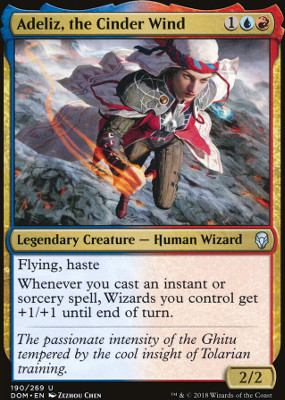Adeliz, the Cinder Wind
Adeliz, the Cinder Wind is the most powerful Wizard in our deck and our best way to finish the game out of the blue. While a 2/2 flying, haste with prowess for three mana is already reasonable, Adeliz, the Cinder Wind doesn't just have prowess itself but essentially gives all of our Wizards prowess. When we can curve out with Wizards from Turn 1 to Turn 3, with our three-drop being Adeliz, it's really easy to untap on Turn 4 and win the game by casting a few cheap spells to pump our team. The end result is that Adeliz, the Cinder Wind isn't just a hasty threat but also plays almost like a lord by pumping the rest of our team into immense threats!
Stormchaser Mage
Stormchaser Mage is best friends with Adeliz, the Cinder Wind, giving us another hasty, flying, prowess threat that just happens to come down the turn before our pseudo-lord. While Stormchaser Mage is a fine threat on its own, often hitting for two or three evasive damage as we cast our spells, it gets really insane with Adeliz, since it essentially has double prowess, so each spell we cast gives our two-drop +2/+2. This means that something as simple as Turn 2 Stormchaser Mage, Turn 3 Adeliz, the Cinder Wind, Turn 4 double-Lightning Bolt (which happens more often than you'd think, since we have eight Bolts) ends up being 19 damage all by itself, which means if our opponent cracks a fetch land, we happen to get in an incidental point of damage, or we have another spell to trigger prowess, we have an evasive Turn 4 kill!
Soul-Scar Mage
Soul-Scar Mage is basically a one-drop ground version of Stormchaser Mage without the haste. While this makes it less powerful, it's still a reasonable threat, especially when Adeliz gives it double prowess. One of the biggest upsides of prowess creatures in general is that they are extremely difficult to block because our opponent never knows if we'll have a spell or two to pump our creatures and make the blocks bad, which often allows us to sneak in for extra damage that we wouldn't get with non-prowess creatures. For example, if we play a Soul-Scar Mage on Turn 1 and our opponent plays a Grim Flayer, we can almost always attack, even if we don't have a spell, since our opponent has to respect the possibility that we do have an instant to blow them out with prowess.
The other big upside of Soul-Scar Mage is that its ability to turn non-creature damage into −1/−1 counters helps us deal with bigger creatures that would otherwise be problematic. Let's say our opponent plays a Tarmogoyf, Thought-Knot Seer, or Gurmag Angler. Our Lightning Bolts can't directly kill any of these creatures because they don't offer enough damage, but if we have a Soul-Scar Mage on the battlefield, we can simply make Thought-Knot Seer into a 1/1 or Gurmag Angler into a 2/2 by putting some counters on it with a Lightning Bolt or Wizard's Lightning. Not only is a 2/2 Gurmag Angler much less threatening than a 5/5 Gurmag Angler, but it also means that we can finish it off when we draw another Bolt later in the game, even if our opponent kills the Soul-Scar Mage in the meantime.
Ghitu LavarunnerSage of Epityr
Ghitu Lavarunner is a lot better than it looks. While it isn't a Goblin Guide on Turn 1, it's pretty easy for our deck to have two spells in the graveyard by Turn 2 or 3, turning future copies into hasty 2/2s for the rest of the game. Plus, as a Wizard, it benefits from Adeliz, the Cinder Wind and becomes a pretty reasonable threat in the mid-game, often attacking as a 3/3 or 4/4. Basically, our deck really wanted another budget-friendly Wizard one-drop, and Ghitu Lavarunner—while perhaps the least powerful creature in the deck—fits the bill.
Meanwhile, Sage of Epityr looks pretty strange, being much less aggressive than the rest of the Wizards in our deck, but it does have one very specific purpose: allowing us to stack the top four cards of our deck in any order we choose. Why would we want to stack the top of our deck? To answer this question, we need to look at our burn spells.

